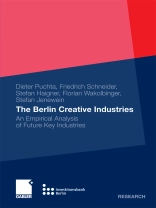The Creative Industries have recently come into the focus of urban development strategies and economic policy. The driving force behind that was, amongst others, Richard Florida with his bestseller “The rise of the creative class and how it’s tra- forming work, leisure, community, and everyday life”. The Creative Industries are increasingly dynamic and growing three times faster than the economy in total. With respect to the economic value added, the Creative In- 1 dustries in Germany are absolutely comparable to the automotive industry. Nonetheless, for entrepreneurs it is often still easier to find financing opportu- ties for property, real estate and assets than for ideas and intangible assets. Thus, – vestitionsbank Berlin has been researching possibilities to finance the Creative Economy since several years. Many who are engaged in spurring the development of cities and regions, h- ever, come across various different definitions of the term “Creative Industries” and several approaches which cannot be exactly distinguished from one another. This might cause confusion.
Inhoudsopgave
1.- The Notion of Creative Industries.- On the Theory of Creative Industries.- An International Overview on the Creative Industries.- 2.- From Theory to Empirics.- The Berlin Creative Industries at a Glance.- The Creative Industries in Detail.- Excursus: Differences among Research Results.- 3.- Value Added and Employment.- Conclusions.- 4.- Instruments to Foster the Creative Industries.- Executive Summary.
Over de auteur
Prof. Dr. Dieter Puchta is consultant for strategic business development.
Prof. Dr. Friedrich Schneider is Professor of Economics at Johannes Kepler University of Linz.
Dr. Stefan D. Haigner, Mag. Stefan Jenewein und Dr. Florian Wakolbinger are self-employed in applied economic research and lecturers at the Universities of Innsbruck and Linz.












